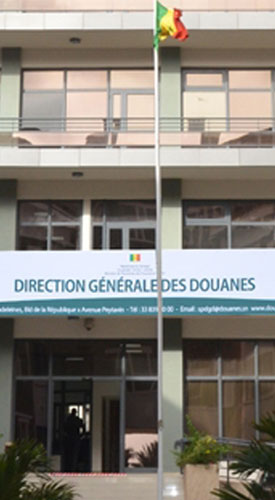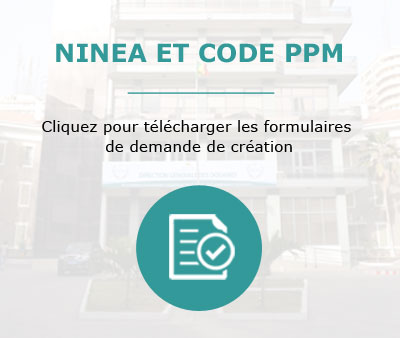The obligationto fill an accounting declaration
Pursuant the provisions of article 69 of the Customs Code, all imported merchandise, including those exempted of duties and taxes, must be accountedin a declaration which assigns them to a customs regime.
Normaly, the accounting is deposited after the arrival of the merchandise, however the customs administration, in its will to facilitate and support trade operators, has put in place simplified procedures and a facilitation system. This is how, for example, it has accepted the concept of an anticipated accounting which allows the clearance of merchandise as soon as they arrive.
Habilitated customs broker
In Senegal, Importers have to seek the services of an authorised customs broker.
However, natural or legal persons benefitting from goods removal credits or special authorizations can account for their own company or trade.
Required documents for accounting
The accounting document includes all indications concerning the import (nature of merchandise, weight, quantity, the value, payable duties and taxes, and other elements).
Enunciations and references on the accounting document should be confirmed by attached document such as :
- the commercial invoice,
- the shipping note (bill of lading, Air waybill AWB, etc.),
- the Certificate of Origin,
- insurance certificate,
- a health certificate or phytosanitary certificate (wether it is a product originating from animals or plants),
- the pre-import declaration,
- verification certificate,
- the decaration of imported food products (DIPA),
- the declaration of particulars relating to customs value,
- other documents related to the import.
The customs information system named GAINDE 2000 has integrated ORBUS 2000, an application which allows :
- the electronic compilation of all documents mentioned above;
- the possibility to visualize all the documents, signed by the qualified authorities, on screen (which is equivalent to attaching them to the accounting document) ;
- the electronic payment of duties and taxes.
The Progamme for Import Verification (PVI)
Ruled in Senegal since 1991, this programme (PVI) consists in inspection, before shipping, of merchandise for Senegal.
The system is build onthe Pre-import Declaration (DPI) which is prior to it. It is handed over to the inspection company, by the importer, when the FOB value of the merchandise is superior or equal to 1.000.000 F CFA.
Except for the merchandise which are exempted and are part of a detailed list, the pre-shipping inspection, based on the DPI, becomes obligatory :
- as soon as the FOB value of merchandise is equal or superior to 3.000.000 F CFA ;
- when it comes to personalized containers (FCL, LCL, etc.), whatever the value.
However, in order to conciliate security preoccupations and trade faciitation, a new risk management computer system (SIAR) and he uuse of X rays pictures (scanner) have been integrated to the PVI. these changes implies:
- Merchandise exempted from PVI and pre-shipment inspection will allways be wil allways be submitted to a DPI with the mention « not submitted ». For these merchandise, the inspection company will only register the DPI;
- Merchandise under PVI regulations will continue to be under DPI rules with the mention « not submitted ». However the inspections will be made following on of the regulations thereafter which will be recorded after a deep analysis of the nature of the operation :
- Documents check without inspection before shipment;
- Documents check completed by a scanner drive at the arrival in Dakar;
- Documents check with inspection shipping the merchandise, as it was done within the PVI.
In all these cases, the intervention of the inspection company is materialized by a Certificate of Verification (AV). Therefore, for all DPI mentionning « submitted » shoud correspond to a certificate of verification, whose ommittance at the deposit of the accounting declaration, sall be deemed a circumvention of the PVI and therfore be punished.
Automation of customs clearance chain
Cusotms information system «GAINDE» covers all customs operations from going through customs to the clearance of goods. Along with the current modules (manifesto, accounting, revenue, customs, tariff and tables), new functionalities have been added to the system :
- lpre-clearance with the help of the manifesto targetting ;
- Exchange of Computer Data (EDI) ;
- the inclusion of different types of containers ;
- automatic attribution of the customs release note ;
- improvement of itinerary criteria for visit;
- facilitation of visit procedures ;
- risk calculation ;
- taking into account the certificate of recognition from the service ;
- wind-ups management ;
- following of suspended duties (regimes C138) ;
- stores and clearance area management ;
- interconnection with the value management system;
- connection with exemption management plateform ;
- intégration of ORBUS 2000 application to collect and compile documents to be attached when accounting.
taxation applicable to imported merchandise
For a better comprehension of taxation regime applicable to impotered merchandise, one has to distinguish product originating from the WAEMU area (UEMOA) or from the ECOWAS (CEDEAO) from third-party products (out from WAEMU and ECOWAS area).
Merchandise originating from teh WAEMU and included in Community Preferencial Tax (TPC), when imported in member-states, become free of all other taxes and duties (Common External Tariff) on the exception, in this case, Value Added Tax and other internal taxes. This also goes for products from teh ECOWAS area and listed under the ECOWAS Trade Liberalisation Scheme.
Products originating from third countries, imported in Senegal, are subject to the Common External Tariff (TEC) which has been in place since January 1st 2000.
Entry tax and duties are as follow :
- customs duty ;
- the statistical charge ;
- the Community Solidarity Tax;
- cyclical import tax on particular products: (sugar, wheat flour, concentrated tomato, fruit juice, sweet concentrated milk and sugar free) ;
- ECOWAS Commnity Tax ;
- the tax to the benefit of pastoral funds;
- Added Value Taxes ;
- the COSEC tax (for seaway imports) ;
- other internl taxes (on alcohol, carbonated drinks, fat food, fabrics, etc.) ;
- the registration fee for vehicules ;
- surchages on certains products (cigarettes, garden onions potagers, pommes de terre, etc.).
Dans un souci de simplification, il ne sera donné, dans les développements qui suivent, que les taux cumulés des droits et taxes ci-dessus, ces derniers pouvant s’appliquer cumulativement ou sélectivement selon le cas.
The base
Since the entry into force of WTO, the customs value of merchandise is the customs value, meaning teh real price to pay or already paid for those merchandise sold for the exports to Senegal and incorporating all costs (transport, assurance, etc.) including the introduction point within the customs territory. This value must be materialised by all written proof of the reality, the truthfulness and the accuracy of the transaction (invoice, contract, etc.).
Otherwise, the service is habilitated to proceed to the evaluation of merchandise by successive application of the following substitution methods listed by the agreement:
- the transactional value of the same merchandise (the same) ;
- the transactional value of similar merchandise (which looks like them) ;
- la valeur des marchandises établie selon la méthode de la valeur déductive (basée sur le prix de vente sur le marché du pays d’importation, déduction faite des frais supportés après le dédouanement) ;
- la valeur des marchandises établie selon la méthode de la valeur calculée (basée sur les coûts de production des marchandises dans le pays de production) ;
- la valeur des marchandises établie selon la méthode du dernier recours (qui est une application souple des méthodes précédentes, s’agissant notamment des quantités, du lieu, du moment, etc.).
Le calcul et les modalités de perception des droits et taxes
Les droits et taxes dont sont passibles les marchandises importées sont payés soit au comptant, soit à crédit pour les bénéficiaires d’un crédit d’enlèvement. Ils sont perçus selon un calcul ad-valorem, c’est-à-dire assis sur la valeur CAF, ainsi qu’il suit :
Montant des droits et taxes = Valeur CAF X taux cumulé
L’enlèvement des marchandises
Une fois les droits et taxes payés, le vérificateur délivre le bon à enlever qui permet au propriétaire de disposer de sa marchandise. Aucun enlèvement ne peut être effectué sans paiement des droits et taxes, d’une consignation ou, dans certains cas, dépôt d’une garantie suffisante.
Certains produits répondent à des normes de taxation très spéciales, que nous nous proposons d’exposer dans les lignes qui suivent. Il s’agit principalement du sucre, des huiles végétales raffinées, des cigarettes, du riz brisé, des pommes de terre, de la farine de blé, des oignons, du concentré de tomate, des boissons gazeuses et liquides alcoolisés.
Dans tous les cas, le montant des droits et taxes dus à l’occasion d’une importation s’obtient suivant la formule encadrée ci-dessus.












